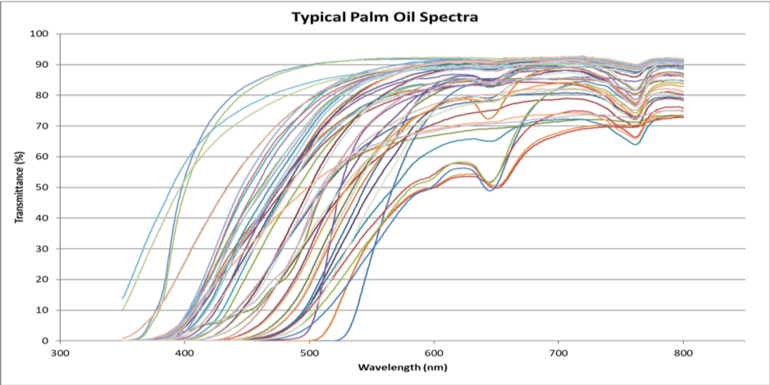The increasing trend of oil usage worldwide and the resultant effect on price fluctuations is driving the need for more accurate analysis within the supply chain. Specific to this is the rising popularity of Palm Oil and its derivatives: non-repetitive analysis across refineries, however, is still an issue.
Palm Oil is unique in its fractionation – resulting in different melting points for different applications. This makes the sample temperature and sample heating to maintain the temperature during measurement more important since temperature and colour go hand in hand. Temperature and duration times must be accurately set to ensure heating to the full liquid phase for measurement, while bearing in mind that overheating can cause the oil to turn darker. Microwave heating is faster but may not result in uniform temperatures of the oil. Further, due to the high melt temperature, Palm Oil shortens very quickly: as soon as the temperature is removed, it starts to solidify, visually turning the sample increasingly whiter.
During the 2018 AOCS Annual Meeting & Expo in Minneapolis last May, Dr Peter Clarke from Lovibond Tintometer presented on the company’s findings, looking at comparative data from various real-life applications and the resultant spectral data received from the measurements: analysing how improvements may be made for closer inter-company agreement. The presentation provided an insight into some of the challenges of the Palm Oil Industry and the processes and practices that could be established to minimize the effects.
Politics and sensitivity aside, the reality is that Palm Oil is used in 50% of the products we buy and is the highest yielding vegetable oil crop, far in excess of Sunflower, Rapeseed, Olive and Coconut oils. It is estimated that it is used in 30% of all vegetable oil production and 10KG is consumed by every European and American annually. Palm Oil is also produced internationally with high areas of production in Central & South America, Africa and, of course, Malaysia.
Yes, there are arguments about its sustainability: deforestation and fires; loss of species such as orangutans and tigers; the displacement of indigenous people and workers’ conditions. Greater awareness, however, is starting to have a positive affect with the introduction of the Roundtable on Sustained Palm Oil (RSPO), higher levels of certification and investment in both worker benefits and biodiversity.
Another improvement is to increase the useable yield of Palm Oil in production and preventing any rejection throughout the supplier chain. Agreement on the exact colour of the oil being transferred is an important quality control between supplier and receiver. There are still issues, however, of disagreement between laboratories partly due to the measuring instrument’s type, the method of measurement, the preparation of the sample and the variability of the oil itself.
The fractional crystallization of Palm Oil has already been mentioned. Whereas the colour of most other oils are measured at 10-30°C above the single melting point, Palm Oil fractions melt at different temperatures: 24°C, 35°C, 42°C, 54°C, 64°C. An appropriate measurement temperature needs to be chosen to melt all the fractions present in the palm oil sample.
The standard colour scales for the measurement of Palm Oil are Lovibond® RYBN (Red, Yellow, Blue, and Neutral), Lovibond® RY, AOCS Tintometer RY. Many also utilise the RY 1:10 for a quick reference.
In order to enhance the Reproducibility of Colour Measurement, it is essential that the supplier and the recipient both agree on the colour scale being used, the sample temperature (ideally 80°C) and, if possible, the instrument being used.
Palm oil sample preparation is key to good colour measurement agreement. Colour is an important measurement of the quality and, hence, value of Palm Oil. Misinterpretation in the industry can result in rejection, antagonism between suppliers and costs.
Palm Oil use is widespread and needs to be done sustainably. These are just a few steps to seeing that is achieved.
